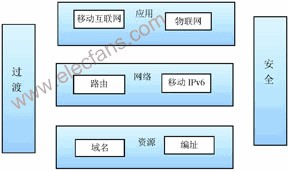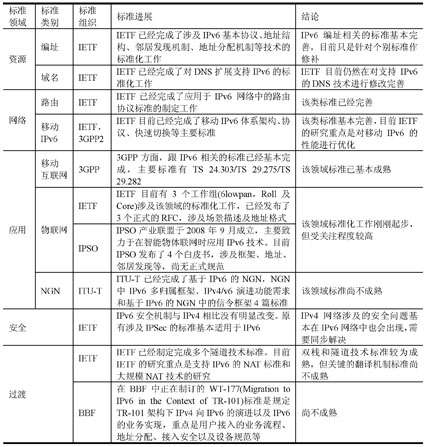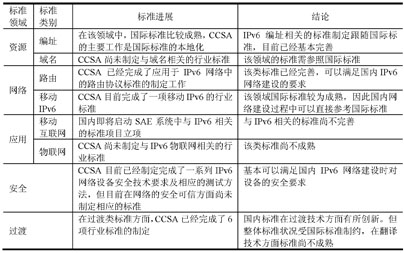The IPv6 standard is mainly divided into 5 categories, namely, resource category, network category, application category, security category, and transition category. See Figure 1 for details.

Figure 1 Classification of IPv6 standards
Resource standards are the core standards that distinguish IPv6 and IPv4, and mainly include addressing technical standards and domain name technical standards. Network standards are standards related to IPv6 network layer technology, mainly including routing technology standards and mobile IPv6 standards. Application standards are the standard specifications that IPv6 technology needs to follow when it is applied to mobile Internet, Internet of Things and other applications. Transitional standards are technical standards involved in the transition from IPv4 to IPv6.
Among various standards, the resource, network, security, and transition standards are mainly studied and formulated in the IETF, and the BBF (Broadband Forum) is also developing IPv4 / v6 network transition standards involving access to the convergence network; mobile Internet standards Mainly formulated in 3GPP; standards related to the application of IPv6 in the Internet of Things are currently mainly formulated in the IETF and IPSO (IP for Smart Objects) alliance; ITU-T mainly develops IPv6 standards related to NGN.
2 International standards
IETF is the main body of international IPv6 standardization. Since 1995, the IETF has formulated more than 200 IPv6-related RFC standards, and the IPv6 core standards have been completed. The current work is mainly focused on the transition from IPv4 to IPv6, as well as to supplement and improve the existing IPv6 standards. In addition to IETF, other international organizations, such as 3GPP, 3GPP2, and ITU-T, have also formulated some standards for IPv6 applications. The 3GPP / 3GPP2 standard also determines that IPv6 is the development direction of 3G / B3G network bearers and service applications. In the IMS stage of 3G / B3G, the network system (including packet domain and circuit domain) will be based on or compatible with IPv6. Including transmission network, user equipment and IMS subsystem equipment, as well as interfaces and protocols all support IPv6 and mobile IPv6, etc .; ITU-T focuses on the scenarios and requirements of IPv6 applied to NGN.
2.1 Resource standards
(1) Addressing standards
IETF has completed the standardization work involving IPv6 basic protocol, address structure, neighbor discovery mechanism, address allocation mechanism and other technologies, and has published 118 related RFCs. These standards are basically perfect, and the current standardization work in this field focuses on maintaining and supplementing the original protocol standards.
(2) Domain standard
The IETF has basically completed the standardization of DNS extension support for IPv6, and has released 11 related RFCs. These standards are basically perfect. The current standardization work in this field focuses on the maintenance and supplementary improvement of the original protocol standards.
2.2 Network standards
(1) Routing standards
Corresponding to the IPv4 routing protocol, the IETF has completed the formulation of routing protocol standards applied to IPv6 networks, and released the RIP, OSPF, BGP, IS-IS and other routing protocols, multi-homed technology and IPv6 MPLS VPN. 29 RFC standards. This type of standard has been perfected, and the routing protocols used in existing IPv4 networks basically have corresponding IPv6 versions.
The IETF is currently studying the formulation of next-generation routing mechanism standards. This type of standard has already taken into consideration the IP version compatibility during the formulation process and will be directly applicable to IPv6 networks.
(2) Mobile IPv6 standard
The IETF has completed major standards such as mobile IPv6 architecture, protocols, and fast switching, and has released 35 related RFCs. Such standards are basically perfect, and the current research focus of IETF is to optimize the performance of mobile IPv6.
3GPP2 has basically completed the protocol of mobile IPv6 application in cdma2000 network.
2.3 Application standards
(1) Mobile Internet
In terms of 3GPP, the standards related to IPv6 have been basically completed. The main standards are TS 24.303 / TS 29.275 / TS 29.282. Once the 3GPP standards involve interaction with the IETF, it is up to the 3GPP to provide corresponding requirements and issue a contact letter to the IETF. Then it is done by IETF. In 3GPP, the items that mainly interact with IETF are IMS-related and SAE-related standards.
In terms of mobile network transition, China Mobile established a new research topic in 3GPP SA2 in May 2009. The name is "Study on IPv6 MigraTIon" and the topic number is TR 23.975. It mainly studies how IPv4 networks evolve to IPv6 networks, including research on evolution scenarios, solutions, impact on network elements, impact on compatibility and interoperability, etc. Currently, it has just passed the project application and there is no manuscript input.
(2) Internet of Things
IETF currently has 3 working groups (6lowpan, Roll, and Core) involved in standardization work in this field, and has released 3 formal RFCs, covering requirements, scenario descriptions, and bearing methods. The IPSO Industry Alliance was established in September 2008. It is mainly dedicated to the application of IPv6 technology in the networking of smart objects and plays a role in industrial coordination. Currently, the IPSO has published four white papers covering frameworks, addresses, neighbor discovery, and protocol stack requirements. The alliance will mainly work on the results of the IETF's 6lowpan and Roll working groups. Overall, although the standards of the Internet of Things involving IPv6 are still in the early stages of drafting, they have developed rapidly, and the relevant standards groups and industry alliances are relatively active.
(3) NGN
ITU-T has completed four recommendations for NGN based on IPv6, IPv6 multi-homing framework in NGN, IPv4 / v6 evolution function requirements and signaling framework in NGN based on IPv6.
ITU-T is currently studying and advancing multiple projects such as vertical multi-homing in NGN based on IPv6, ID / Locator separation framework in NGN based on IPv6, network access function requirements in NGN based on IPv6 and IPv6 evolution roadmap for NGN operators .
2.4 Safety standards
The IPv6 security mechanism and security standard system have not changed significantly compared to IPv4. The original standards related to IPSec are basically applicable to IPv6, and the maturity of IPv6 security standards is basically the same as IPv4.
The SAVI working group promoted by Tsinghua University at the IETF is currently studying and formulating a network security mechanism based on source address verification, which is also applicable to IPv6 networks.
2.5 Transitional standards
The transition technology from IPv4 to IPv6 is mainly divided into dual stack, tunnel and translation technology.
(1) For dual-stack technology, only devices or terminals need to support IPv4 and IPv6 protocol stacks, respectively, and follow the corresponding standards.
(2) For the tunneling technology, IETF has formulated a number of tunneling technical standards, including manual tunnel, GRE tunnel, tunnel proxy, 6to4 tunnel, 6over4 tunnel, ISATAP tunnel, and TEREDO tunnel. Carrying out standardization research on flexible wire technology, Tsinghua University submitted multiple drafts in the working group and 2 of them became RFC standards.
(3) For translation technology, the current research focus of IETF is to support IPv6 translation technology standards and large-scale NAT technology research, although there are already a variety of alternative technical solutions (such as CGN (operating grade NAT) technology and IVI technology, etc. ), But these technologies are not yet mature and have not been verified by large-scale network applications.
The WT-177 (MigraTIon to IPv6 in the Context of TR-101) standard being formulated in BBF is to stipulate the evolution of IPv4 to IPv6 under the TR-101 architecture and the realization of IPv6 services, with emphasis on the user access business process and address Distribution, access security, and equipment specifications are currently the industry ’s relatively complete standards for IPv6 deployment in access aggregation networks, and are 70% complete, and are expected to be completed in the first half of 2011.
2.6 Conclusion
Overall, in terms of IPv6 international standards, the current network layer standards are mainly formulated by the IETF. The core standards are mature and can basically meet the needs of pure IPv6 networking, but the transition standards are not yet fully mature. Among the application standards, the traditional The corresponding standards for telecommunication services (such as NGN, softswitch, mobile, etc.) are undertaken by the corresponding standards organizations, with different progress. Some Internet services (such as Web 2.0, etc.) are not related to the underlying bearer protocol and do not require standard support. In terms of specific standard categories, the resource and network protocol standards are relatively complete and can basically meet the needs of pure IPv6 networking; the security standards are not yet mature in terms of network security and trust; among the interworking standards, dual stack and tunnel technology The standard is relatively complete, but the standard of the IPv4 / IPv6 translation mechanism is not mature. In terms of application standards, in terms of mobile Internet application standards, in 3GPP, the standards related to IPv6 have been basically completed, but the research on the standards for IPv4 / v6 transition has just started and is not yet mature; the standards of the Internet of Things involving IPv6 are still The initial stage of drafting, but the development is relatively fast.
See Table 1 for specific progress of IPv6 international standards.
Table 1 Progress of IPv6 international standards

3 Domestic standards
China ’s IPv6 standardization work was fully launched in 2001 and is specifically responsible for the China Communications Standards Association (CCSA). There are more than 30 standards being developed and completed.
3.1 Resource standards
(1) Addressing standards
In this field, international standards are relatively mature. The main work of CCSA is the localization of international standards. At present, standardization work involving IPv6 basic protocols, address structures, neighbor discovery mechanisms, and address allocation mechanisms has been completed. Industry standards, which are basically perfect.
(2) Domain standard
CCSA has not yet formulated industry standards related to domain names.
3.2 Network standards
(1) Routing standards
CCSA has completed the formulation of routing protocol standards applied to IPv6 networks, and has released 7 industry standards including OSPF, BGP, IS-IS and other routing protocols and IPv6 MPLS VPN; the formulation has been completed based on the status of international standards The industry standard of 8 equipment technical requirements and test methods such as IPv6 core router and edge router. In this type of standard, in addition to following international standards, a series of protocol test standards, equipment technology and test standards have been formulated based on the domestic status quo. They are innovative, and these standards effectively support the construction of domestic IPv6 networks. At present, the routing standards have been perfected. The routing protocols used in existing IPv4 networks basically have corresponding IPv6 versions, which can meet the requirements of domestic IPv6 network construction.
CCSA is currently studying the formulation of next-generation network architecture standards. Such standards have taken into account the compatibility of the IP version during the formulation process and will be directly applicable to IPv6 networks.
(2) Mobile IPv6 standard
CCSA has now completed an industry standard for mobile IPv6. International standards in this field are relatively mature, so you can directly refer to international standards during the construction of domestic networks.
3.3 Application standards
(1) Mobile Internet
CCSA is about to start the establishment of standard projects related to IPv6 in the SAE system.
(2) Internet of Things
CCSA has not yet carried out the formulation of industry standards in this field.
3.4 Safety standards
CCSA's current work focuses on the development of IPv6 network equipment security technical requirements. Currently, a series of IPv6 network equipment security technical requirements and corresponding test methods have been developed and completed, including core / edge routers, layer 3 switches, and broadband network access servers. Basically, it can meet the security requirements for equipment during the construction of domestic IPv6 networks, but at present, no corresponding standards have been formulated for the security and credibility of IPv6 networks.
3.5 Transitional standards
In terms of transitional standards, CCSA has completed the formulation of six industry standards, involving tunneling and translation technologies when IPv4 and IPv6 networks are interoperable. In terms of tunnel technology, it is more mature to follow international standards. Among them, the “Technical Requirements for IPv4 Network Interconnection (4 over 6) Based on IPv6 Backbone Network Using Border Gateway Protocol Multiprotocol Extension (BGP-MP)†led by Tsinghua University is an innovative technical standard whose technical content has become IETF The RFC standard. In terms of translation technology, CCSA currently has few achievements and cannot fully meet the needs of the domestic IPv4 / v6 network transition. The "Overview and Basic Address Mapping of IPv4 and IPv6 Network Interconnection Technology Based on Stateless Address Mapping" led by Tsinghua University is one of the hottest technical solutions in the industry, and its technical content has become an IETF RFC draft.
3.6 Conclusion
In general, China's IPv6 standards are still in the position of following international standards as a whole. The progress of IPv6 standards is basically consistent with international standards, and they have made innovations in transition standards (such as flexible wire technical standards and IVI technical standards, etc.). standard. In addition, China has developed a series of equipment technical requirements and test methods, which are innovative and strongly support the construction of domestic IPv6 networks.
See Table 2 for the progress of China's IPv6 standard.
Table 2 Progress of China's IPv6 standard

4 Conclusion
Judging from the current status of IPv6 standardization at home and abroad, the current main problems in the IPv6 standard include:
(1) Immature transition standards
It is mainly reflected in the address translation mechanism. At present, there is no mature technical standard at home and abroad, which is difficult to meet the needs of IPv4 / v6 network interworking.
(2) Immature application standards
The IPv6 related standards currently being developed internationally and domestically are mainly concentrated on the network bearer. There are few standards in the mobile Internet, Internet of Things and other application fields, and the standard system is not fully mature. Therefore, China should seize this opportunity, fully rely on the current domestic CNGI network environment, combined with the existing standards, focus on these two aspects to study and formulate IPv6 standards with innovative content and Chinese characteristics, and actively participate in international cooperation To strive to influence the formulation of international standards with domestic standards, thereby gradually strengthening China's right to speak in the formulation of international standards.
Evolis Cleaning Kit,Evolis Primacy Cleaning Kit,Evolis Cleaning Card,Evolis High Trust Cleaning Kit
Miraclean Technology Co., Ltd. , https://www.mrccleanroom.com
